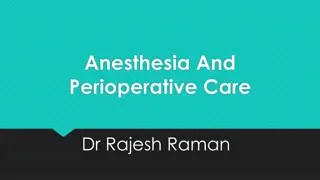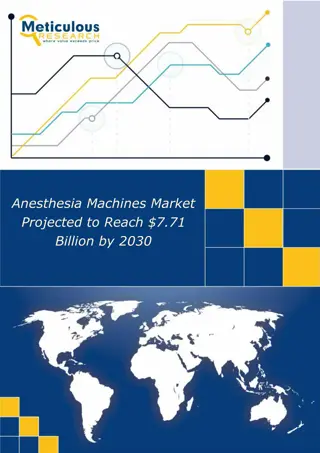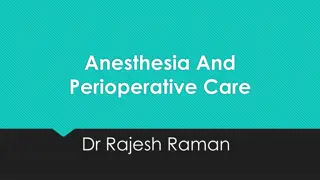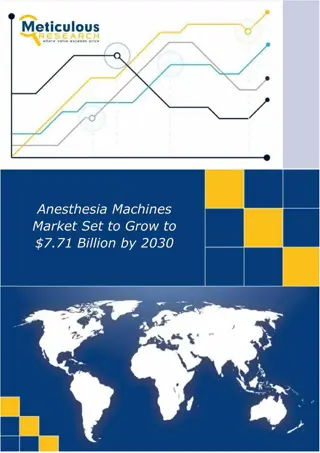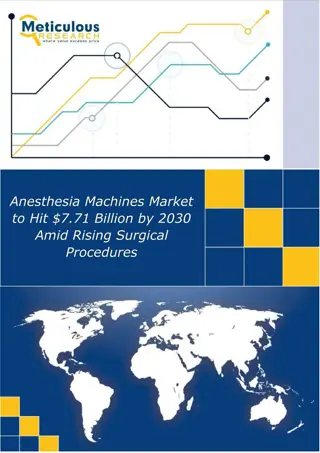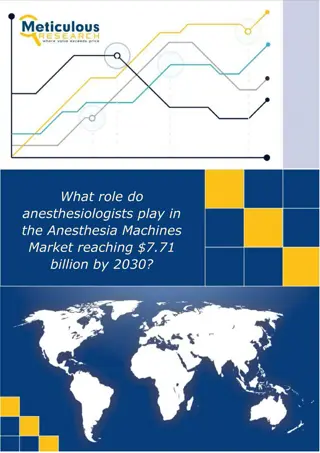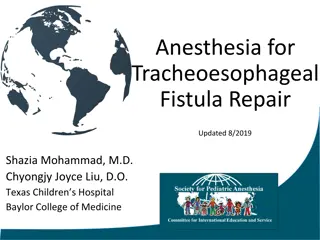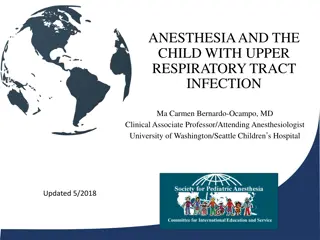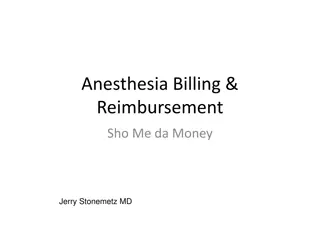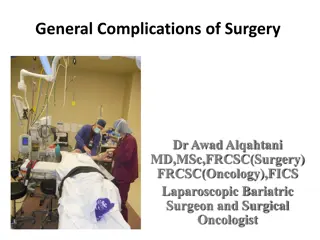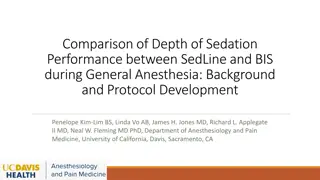Introduction to Local Anesthesia
Local anesthesia involves the loss of sensation in a specific body area without inducing unconsciousness. Learn about its definition, terminology, neurophysiology, and more in this informative content by Dr. Mohammed Alaraji.
Download Presentation

Please find below an Image/Link to download the presentation.
The content on the website is provided AS IS for your information and personal use only. It may not be sold, licensed, or shared on other websites without obtaining consent from the author.If you encounter any issues during the download, it is possible that the publisher has removed the file from their server.
You are allowed to download the files provided on this website for personal or commercial use, subject to the condition that they are used lawfully. All files are the property of their respective owners.
The content on the website is provided AS IS for your information and personal use only. It may not be sold, licensed, or shared on other websites without obtaining consent from the author.
E N D
Presentation Transcript
Introduction to Local Anesthesia Dr.Mohammed Alaraji B.D.S.F.I.B.M.S
Local anesthesia Definition "loss of sensation in a circumscribed area of the body caused by inhibition of the conduction process in the peripheral nerves".
An important feature of local anesthesia is that it produces this loss of sensation without inducing loss of consciousness. In this one major area, local anesthesia differs dramatically from general anesthesia.
Terminology Pain: According to the (WHO) pain is defined as an "unpleasant sensation that occurs from imminent tissue damage . Analgesia: loss of pain. Anesthesia: loss of sensation (loss of pain and touch sensation). Paresthesia: altered sensation (tingling), such as when a local anesthesia is starting to work or its effect is wearing off. Or when a damaged nerve is regenerated. Relative analgesia: is a sedation technique in which the patient remains conscious but mental relaxation is induced by inhalation of a mixture of nitrous oxide and oxygen.
The neuron or the nerve cell is the structural unit of the nervous system; it can transmit messages between the central nervous system and all parts of the body. There are two types of neuron: the sensory neuron and the motor neuron. neurons that can transmit the sensation of pain consist of three major parts which are the cell body, the axon, and the dendrites.
axon is a thin cable-like structure that may be quite long (the giant axon has been measured as 100-200 cm). It is composed of neural cytoplasm and covered by a thin sheath which is the nerve membrane, in some nerves a lipid-rich layer of myelin covers this membrane, and the membrane is known as myelinated nerve fiber. The nerve membrane consists of two layers of lipid molecules (bilipid layer of phospholipids) and associated proteins and carbohydrates. Since the nerve membrane has selective permeability, therefore significant differences exist for ions between the intracellular and the extracellular concentrations.
The function of a nerve is to carry messages from one part of the body to another. These massages, in the form of electrical action potentials, are called impulses. Action potentials are transient depolarization of the membrane that result from a brief increase in the permeability of the membrane to sodium and usually from a delayed increase in the permeability to potassium. Impulses are initiated by chemical, thermal, mechanical, or electrical stimuli.
Mechanism of action of local anesthesia The concept behind the action of LA is that it prevents both the generation and the conduction of a never impulse thereby they act like a roadblock between the source of impulse (as a surgical incision in soft tissue) and the brain. Many theories have been suggested to explain the mechanism of action of LA, in general, the nerve membrane is the site at which LA agents exert their pharmacological actions
the most popular theories are: 1. Membrane expansion theory:this theory states that anesthetic molecules diffuse through the nerve membrane producing a general disturbance of the bulk membrane structure, expanding some critical regions in the nerve membrane and decrease the permeability to sodium ions (decreased diameter of sodium channels), thus inhibiting both conduction and nerve excitation. 2. Specific receptor theory: this is the most favored theory today, it proposes that local anesthetics act by binding to specific receptors in the sodium channel (protein channel) in the nerve membrane, the action of the drug is direct, not mediated by some change in the general properties of the cell membrane. Once the local anesthetic has gained access to these receptors permeability to Na ions is decreased or eliminated and nerve conduction is interrupted.
Factors Affecting the Local Anesthetic Action 1. PH value It is well known that the pH of a local anesthetic solution (as well as the pH of the tissue into which it is injected) greatly influences its action. Acidification of tissue decreases local anesthetic effectiveness. Inadequate anesthesia results when local anesthetics are injected into inflamed or infected areas. The inflammatory process produces acidic products: The pH of normal tissue is 7.4; the pH of an inflamed area is 5 to 6.
2. Lipid solubility Increased lipid solubility of local anesthetics permits the anesthetic to penetrate the nerve membrane more easily. Local anesthetics with greater lipid solubility produce more effective conduction blockage at lower concentrations than less lipid soluble solutions.
3. Protein binding The degree of protein binding of the anesthetic molecule is responsible for the duration of local anesthetic activity. Local anesthetic possessing a great degree of protein binding appear to attach more securely to the protein sites and to possess a longer duration of clinical activity. Longer-acting local anesthetics (e.g., bupivacaine) are more firmly bound in the nerve membrane (increased protein binding) than are shorter-acting drugs (e.g., lidocaine) and therefore are released more slowly from receptor sites in the sodium channels.
4. Vasodilator activity The local anesthetic solution with greater vasodilator activity will increase blood flow to the area; this will lead to rapid removal of anesthetic molecules from the injection site, decreasing anesthetic potency and duration. 5. Vascularity of the injection site The duration is increased in areas of decreased vascularity. 6. Presence or absence of vasoactive substance The addition of a vasopressor into local anesthetic solution decreases the tissue perfusion thus increasing the duration of action.
Properties deemed most desirable for a local anesthetic It should not be irritating to the tissue to which it is applied. It should not cause any permanent alteration of nerve structure. Its systemic toxicity should be low. The time of onset of anesthesia should be as short as possible. The duration of action must be long enough to permit completion of the procedure. It should be relatively free from producing allergic reactions. It should be sterile.
Advantages of local anesthesia 1. Less expensive than general anesthesia (GA). 2. No special preparation of the patient is needed as in GA. 3. No complicated apparatus is needed. 4. Less complication rate than GA. 5. The patient remains awake with no need for aftercare. 6. Can be used if GA is contraindicated (the patient is unfit for GA). 7. Anesthetist and other additional trained personnel are not required. 8. The technique is not difficult to master.
A. Diagnostic: example is a patient with myofacial pain who is convinced that an upper tooth is causing the problem; LA may help this patient and the surgeon in this situation to eliminate the tooth as the cause of pain and may thus avoid unnecessary treatment.
B. Therapeutic: LA can constitute part of a treatment for painful conditions, for example, the use of block technique to eliminate the pain of dry socket. Blocks of the inferior alveolar nerve, mental nerve or infraorbital nerve can also be used for the treatment of trigeminal neuralgia when pain breakthrough.
C. Preoperative: The provision of pain-free operation is by far the most common use of LA providing an effective and safe method for almost all outpatient dentoalveolar surgical procedures. It can in conjunction with sedation techniques allows more difficult procedures to be carried out without the additional risks of general anesthesia and this is particularly of value in patients with significant cardiovascular or airway diseases.
D. Adjunct to General Anesthesia: LA is also given to patients undergoing oral and maxillofacial surgery under general anesthesia this serves the following purposes: 1. It reduces the depth of general anesthesia needed. 2. It provides local homeostasis to the operative site. 3. Provides immediate postoperative analgesia.
E. Postoperative After surgery with either local or general anesthesia the continuous effect of the anesthesia is the most beneficial way of reducing a patient's discomfort, it helps to reduce or even eliminate the need for a stronger systemic analgesic.



